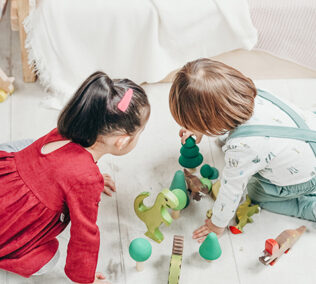Helping Young Children and Their Caregivers
Transition Back to Childcare
Julie Ribaudo, LMSW, ACSW, IMH-E
Attending to the well-being of young children and their caregivers in the transition back to childcare entails attention to the physical, social and emotional health of all of those involved (children, parents, and childcare providers). Developing recommendations for infants and young children must include strategies to maintain physical health and safety, while also being attentive to emotional health and security. While social distancingis recommended to mitigate the spread of infection, emotional proximity is developmentally necessary for young children to feel safe and secure, especially in times of transition and uncertainty. For infants and young children, social emotional health and well-being requires physical safety and the emotional security that comes from being able to turn to their trusted caregivers for comfort and care.

Facilitating young children’s successful transition to child care in the midst of a pandemic will require attention to several factors, including attention to children’s emotional reactions to the separation from their family, and reunion with their teacher/friends at childcare; the need to re-establish new routines; the developmental need for the continuity of a relationship with a trusted adult; and the ability of the child care providers to meet the emotional needs of the children, while recognizing that providers are also experiencing the wide-spread effects of the COVID-19 pandemic, and also need to feel safe, secure and supported.
Another consideration is that children will experience the effects of this pandemic differently, and their individual responses as they return to childcare will likely vary. For some children, having more time with their parent(s) may have been a welcome experience, thus making a return to childcare a potential source of stress and sadness. For other children, the disruption of the routine and relationship with their childcare provider, may have been experienced as a loss and trauma, and the reunion with the caregiver who “abandoned them” (in the child’s eyes) may contribute to expressions of ambivalence and anger in some children upon the subsequent reunion with their caregiver/teacher. In addition, some children will have suffered other losses or endured experiences that have threatened their sense of security during the stay-at-home order. These children will require additional comfort, stability and emotional availability of their teacher/caregiver to help mitigate the negative impact of cumulative stress.
Finally, to ensure the well-being of the children, it is also imperative to ensure the well-being of their teachers and caregivers, and to provide them with the emotional and administrative supports necessary during this time of re-integration, and in the months ahead. As essential workers in the COVID-19 pandemic, child-care providers may have worries about their own physical or psychological health, and the potential risk to their family members at home. Because young children internalize stress vis-à-vis the adults who care for them, it is vitally important to provide supports and services to the childcare providers to ensure their emotional well-being. Strategies to “help the helpers” can include professional development supports such as access to behavior health consultation, and reflective consultation, which can help providers remain emotional available, sensitive, and responsive to the needs of the infants and young children they care for.
For Parents
For Childcare Providers
What to Expect from Children
You already know that children express their thoughts and worries in a variety of ways. You may find their behavior somewhat confusing as they re-integrate to childcare. That may suggest the child sorting through their own confusion.
Patterns of stress response you may see:
They are bound to be wondering about the “germ” and where it is. They may wonder why it is okay to come back to school now. They will notice and possibly react to changes, such as new routines, teachers in masks, the heightened emotions of the adults around them, loss of friends they expected to see, etc.
Providing predictable routines and offering the reassurance of your emotional and physical presence can go a long way to help young children feel safe and secure. You can help them by building in games that deal with separation and loss, such as hide-n-seek or peek-a-boo.
When children’s behavior is confusing or upsetting, it can be helpful to pause and ask yourself, “What is the child doing? What might they be feeling? What do they need (attention, help, movement, connection with you or for you to notice and delight in them in some way)? How can I help them with their feelings and to restore their sense of emotional security and safety?” When children feel good, they usually act “good.” It is worth the effort to sort through the meaning of their behavior, even though it is challenging for the caregiver at times. If you find yourself short-tempered or impatient, making “repair” with a child when you are calm by talking with them about what happened, apologizing if you frightened or alarmed them, and reassuring them of your care for them can help build their relationship with you.
Some children who suffered extra stress, or who have suffered earlier traumas, may be especially hard to help right now. Behavioral health consultants and/or a reflective consultant may be a source of support as you work to reassure and provide safety for these children and navigate the challenging and uncertain days ahead.
